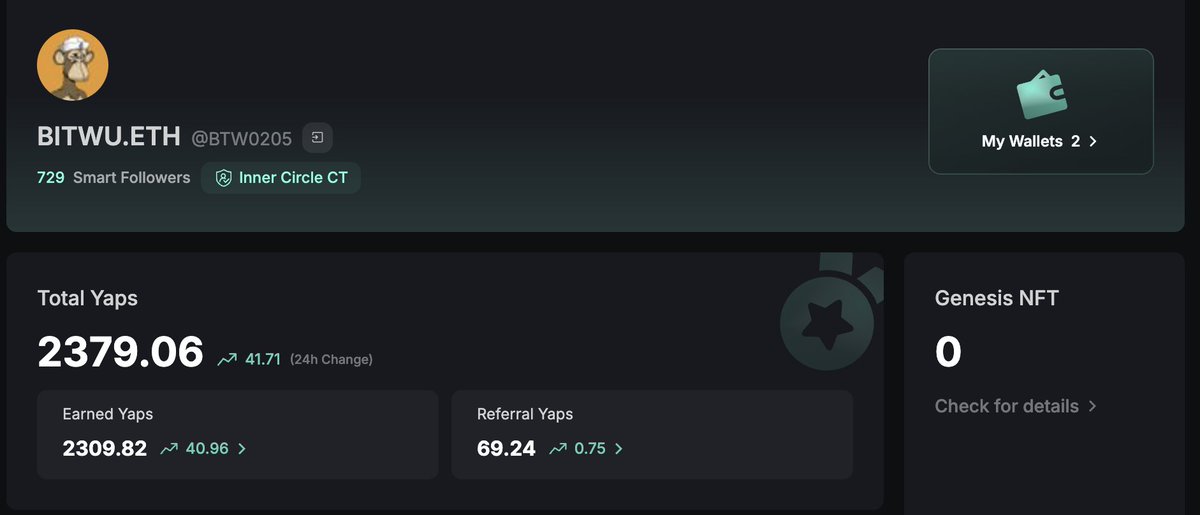🧐 After being "ignored" by Kaito's airdrop, I finally understand where I went wrong—
High YAP score ≠ stable airdrop | The three-dimensional screening mechanism of YAP points, social influence, and content profile;
Thank you all for answering my questions. I haven't paid much attention to this ecosystem, but many Yap friends left comments under this question yesterday;
First of all, Kaito's airdrop distribution mechanism is a non-public rule (gray box) and social identity screening mechanism, meaning that having a high score does not guarantee receiving an airdrop.
To summarize the suggestions from everyone regarding @KaitoAI's tweet yesterday:
1️⃣ Why can others receive Huma / other Kaito airdrops while I have not been able to? The reasons are as follows:
Kaito is an AI-driven Web3 search engine that adopts a "Yap-to-Earn" model, rewarding users with Yap points through social platforms, which may be linked to airdrop distribution.
However, airdrops related to the Kaito project are usually associated with holding Genesis NFTs, Yap point rankings, and interactions and creations within the ecosystem (such as Huma Finance).
- Points are just a reference, not a determining factor:
Although the project emphasizes that the points system (YAP, etc.) is the basis for airdrops,
the actual distribution does not solely consider the score; it mainly looks at whether you have produced in-depth content about the project, whether you have staked NFTs and Kaito tokens;
Especially since the quality of this content is required to be high; if you have not produced relevant content, there will be no airdrop. The role of AI is to assess the content profile;
Of course, it will also consider wallet profiles, social influence, content quality, depth of dissemination, and other dimensions.
Many people simply focus on scoring but do not participate with substantial content, which may be judged as "low-quality participation" or "bot behavior."
I did not receive anything because I did not create relevant content!
- Huma airdrop is a mix of whitelist + points mechanism:
A large number of airdrops are directed to addresses recommended by cooperative KOLs or users with frequent social interactions.
So when you see some people "with low scores but still received it," this reflects the influence of social relationship chains.
Additionally, Kaito ecosystem airdrops (including Huma Finance) provide extra bonuses for Genesis NFT holders. For example, Kaito NFT holders may receive priority allocation of $HUMA or $KAITO.
- The project's screening mechanism leans towards verifiable influence—
For example:
Whether you have participated in early interactions (like/reply/RT official content)
Whether you have linked X/Twitter, Lens, Farcaster, and other social accounts, and maintained long-term activity;
Whether you have content that has been "liked/quoted/discussed" by others (real social influence)
Whether you have active behavior in Discord / X communities;
So to summarize:
For example, the first airdrop of Huma Finance @humafinance was only allocated to the top ~500 Yap contributors. This contribution is not based on your total score but on Mindshare scores (comprehensive assessment over 30 days, 3 months, and 12 months).
Even if your total Yap score is high, if you do not make it to the top of the leaderboard (e.g., top 500 or top 1000), you will not receive an airdrop.
To enter this ranking, you need to either stake tokens and NFTs or produce relevant content to enter the Mindshare ranking;
2️⃣ If you want to earn Kaito project points to receive airdrops, what can you do in the future to increase your chances of receiving airdrops?
✅ 1. Don’t just focus on scoring; participate authentically and leave a trace:
Add tags when searching, comment on addresses, write insights; these interactions may be recorded in the background; don’t repeatedly interact with the same address dozens of times a day, as bulk behavior is easily judged as farming;
✅ 2. Create relevant content, include topics + official references
This is very important; creating relevant content is the main core source for obtaining airdrops. When you have time, you can write and publish about cooperative projects like Huma Finance, OG, infinex, or original analyses, tutorials, or technical comparisons related to the Kaito ecosystem,
Post on the X platform with tags like #Kaito, #HumaFinance, #infinex.
For example, write an article about a project’s user experience, investment research, or reviews, post it on the X platform, @KaitoAI, and if the project team likes or quotes it, it greatly increases your chances of receiving an airdrop;
✅ 3. Keep your social network connections active;
Link X / Lens / Farcaster and interact, especially maintain communication with the project’s official accounts, join Discord, and participate in project tasks, feedback, AMAs, and other activities.
Maintain interaction with other KOLs, reply to, retweet, or quote their tweets to increase content exposure.
Increase interaction: for example, frequently interact with @KaitoAI, @humafinance, strive to enter the top 500 or top 1000, and increase the probability of airdrop distribution.
✅ 4. Diversify across multiple InfoFi projects, don’t put all your eggs in one basket
Lastly, I want to emphasize that Kaito's airdrop distribution mechanism is a non-public rule (gray box) and social identity screening mechanism. Overall, you cannot find the most accurate rules, but it is likely related to the content discussed above, and you need to adjust and find patterns yourself.
Additionally, besides Kaito, projects like Cookie, Bubblemaps, Ethos, etc., are also worth participating in as they are building similar InfoFi × AI × Social Reputation models, with gameplay that is generally applicable;
Yesterday I wrote about @bubblemaps
Next, I will find time to write about @cookiedotfun;

免责声明:本文章仅代表作者个人观点,不代表本平台的立场和观点。本文章仅供信息分享,不构成对任何人的任何投资建议。用户与作者之间的任何争议,与本平台无关。如网页中刊载的文章或图片涉及侵权,请提供相关的权利证明和身份证明发送邮件到support@aicoin.com,本平台相关工作人员将会进行核查。




